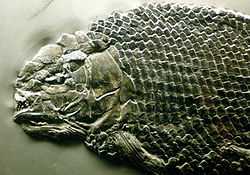Lepidotes
| Lepidotes Temporal range: Early Jurassic, 183–125Ma | |
|---|---|
 | |
| Fossil specimen of L. elvensis | |
| Scientific classification | |
| Kingdom: | Animalia |
| Phylum: | Chordata |
| Class: | Actinopterygii |
| Order: | †Semionotiformes |
| Family: | †Semionotidae |
| Genus: | †Lepidotes Agassiz, 1832[1] |
| Type species | |
| †Lepidotes gigas Agassiz, 1832 | |
| Species[2] | |
|
†L. elvensis (Blainville, 1818) (orig. Cyprinus) | |
Lepidotes is an extinct genus of semionotid neopterygian ray-finned fish from the Jurassic period (Toarcian age) and Early Cretaceous. Fossils have been found in marine sediments of France, England, and Germany,[2] and in Early Cretaceous sediments of Brazil[3] and Bornholm, Denmark (Jydegaard Formation).[4]

Inhabiting both freshwater lakes and shallow seas, Lepidotes was typically about 30 centimetres (12 in) long. The body was covered with thick, enamelled scales.[5] Batteries of peg-like teeth enabled Lepidotes to crush the shells of its molluscan prey.
Lepidotes was one of the earliest fish in which the upper jawbones were no longer attached to the jugal bone. This allowed the jaws to be stretched into a 'tube' so that the fish could suck in prey from a greater distance than in previous species.[5] This system is still seen in some modern fish, such as carp.
References
- ↑ Agassiz, L. (1832), Untersuchungen über die fossilen Fische der Lias-Formation. Jahrbuch für Mineralogie, Geognosie, Geologie und Petrefaktenkunde 3: 145
- ↑ 2.0 2.1 López-Arbarello, A. (2012). "Phylogenetic Interrelationships of Ginglymodian Fishes (Actinopterygii: Neopterygii)." PLoS ONE, 7(7): e39370. doi:10.1371/journal.pone.0039370
- ↑ John G. Maisey, Discovering Fossil Fishes, 1996:150, 152.
- ↑ Bonde, N.; Cristiansen, P. (2003). "New dinosaurs from Denmark". Comptes Rendus Paleovol. 2 (13). doi:10.1016/51631-0683(03)00009-5.
- ↑ 5.0 5.1 Palmer, D., ed. (1999). The Marshall Illustrated Encyclopedia of Dinosaurs and Prehistoric Animals. London: Marshall Editions. p. 37. ISBN 1-84028-152-9.